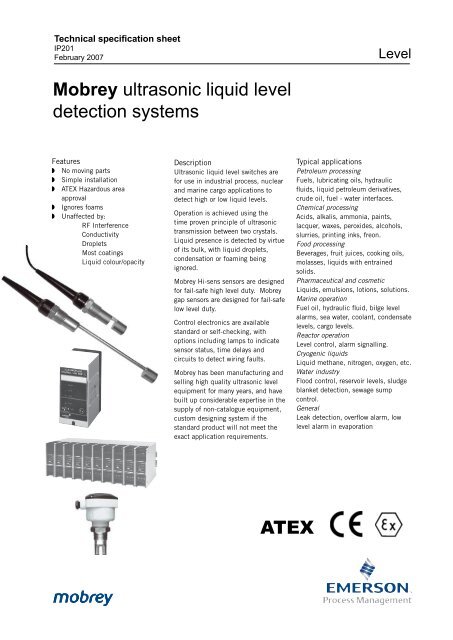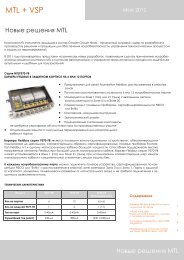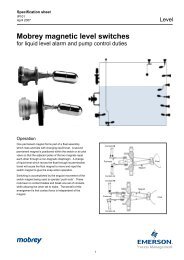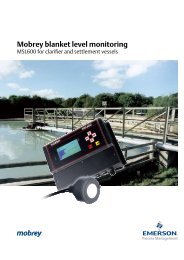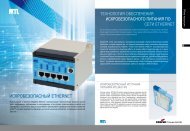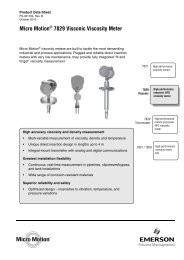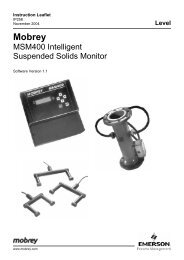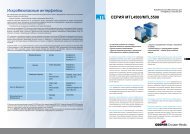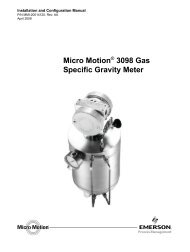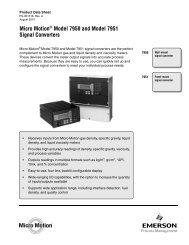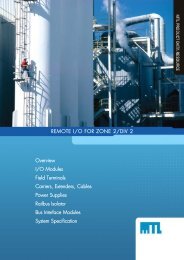Mobrey ultrasonic liquid level detection systems ATEX
Mobrey ultrasonic liquid level detection systems ATEX
Mobrey ultrasonic liquid level detection systems ATEX
You also want an ePaper? Increase the reach of your titles
YUMPU automatically turns print PDFs into web optimized ePapers that Google loves.
Technical specification sheetIP201February 2007Level<strong>Mobrey</strong> <strong>ultrasonic</strong> <strong>liquid</strong> <strong>level</strong><strong>detection</strong> <strong>systems</strong>Features No moving parts Simple installation <strong>ATEX</strong> Hazardous areaapproval Ignores foams Unaffected by:RF InterferenceConductivityDropletsMost coatingsLiquid colour/opacityDescriptionUltrasonic <strong>liquid</strong> <strong>level</strong> switches arefor use in industrial process, nuclearand marine cargo applications todetect high or low <strong>liquid</strong> <strong>level</strong>s.Operation is achieved using thetime proven principle of <strong>ultrasonic</strong>transmission between two crystals.Liquid presence is detected by virtueof its bulk, with <strong>liquid</strong> droplets,condensation or foaming beingignored.<strong>Mobrey</strong> Hi-sens sensors are designedfor fail-safe high <strong>level</strong> duty. <strong>Mobrey</strong>gap sensors are designed for fail-safelow <strong>level</strong> duty.Control electronics are availablestandard or self-checking, withoptions including lamps to indicatesensor status, time delays andcircuits to detect wiring faults.<strong>Mobrey</strong> has been manufacturing andselling high quality <strong>ultrasonic</strong> <strong>level</strong>equipment for many years, and havebuilt up considerable expertise in thesupply of non-catalogue equipment,custom designing system if thestandard product will not meet theexact application requirements.Typical applicationsPetroleum processingFuels, lubricating oils, hydraulicfluids, <strong>liquid</strong> petroleum derivatives,crude oil, fuel - water interfaces.Chemical processingAcids, alkalis, ammonia, paints,lacquer, waxes, peroxides, alcohols,slurries, printing inks, freon.Food processingBeverages, fruit juices, cooking oils,molasses, <strong>liquid</strong>s with entrainedsolids.Pharmaceutical and cosmeticLiquids, emulsions, lotions, solutions.Marine operationFuel oil, hydraulic fluid, bilge <strong>level</strong>alarms, sea water, coolant, condensate<strong>level</strong>s, cargo <strong>level</strong>s.Reactor operationLevel control, alarm signalling.Cryogenic <strong>liquid</strong>sLiquid methane, nitrogen, oxygen, etc.Water industryFlood control, reservoir <strong>level</strong>s, sludgeblanket <strong>detection</strong>, sewage sumpcontrol.GeneralLeak <strong>detection</strong>, overflow alarm, low<strong>level</strong> alarm in evaporation<strong>ATEX</strong>
System descriptionA <strong>Mobrey</strong> <strong>ultrasonic</strong> <strong>liquid</strong> <strong>level</strong>control comprises:• A tank mounted sensor containingtransmitter and receiver crystals• An RF sensor drive and detectorelectronic circuit, which may beintegral with the sensor or mountedadjacent to the sensor dependingupon vessel conditions or accessconsiderations.• A control unit mounted remotely tomonitor the sensor state and providethe required switching functionChoice of sensor<strong>Mobrey</strong> gap sensors<strong>Mobrey</strong> gap sensors energise a relayoutput when there is a <strong>liquid</strong> presentbetween the transmitter and receivercrystals of the sensor. In this way,absense of <strong>liquid</strong>, power failure ordamage to plant cabling will result inan alarm condition.Gap sensors are fail-safe low <strong>level</strong>.Typical applications• Pump protection• Vessel empty protection• Foam/froth <strong>detection</strong>• Pump control<strong>Mobrey</strong> Hi-sens sensors<strong>Mobrey</strong> Hi-sens sensors operate ina reverse manner. The transmitterand receiver crystals communicatearound the wall of the sensor whenit is dry. Presence of <strong>liquid</strong> aroundthe sensor damps out the 'ringing' ofthe sensor and an alarm condition isthen signalled.<strong>Mobrey</strong> Hi-sens is therefore failsafehigh <strong>level</strong> and will signal an alarmcondition on presence of <strong>liquid</strong>,power failure or damage to plantcabling.Typical applications• High <strong>level</strong> alarm• Overfill prevention• Leak <strong>detection</strong>Ultrasonic sensor operation can beadversely affected by the presenseof excessive aeration, solids orfoam in the <strong>liquid</strong>. If you have anapplication query contact <strong>Mobrey</strong> forexpert advice on the selection of asuitable <strong>liquid</strong> <strong>level</strong> <strong>detection</strong> systemSensors may be mounted in anyposition to signal <strong>liquid</strong> presence.Sensor with adjacent amplifierSensorwith headamplifier<strong>Mobrey</strong> gap sensor: General purpose failsafe low <strong>level</strong>b) Sensor in <strong>liquid</strong>The <strong>ultrasonic</strong> signalreaches receiver crystalTransmittercrystala) Sensor in airThe <strong>ultrasonic</strong> signal willnot reach receiver crystalReceivercrystalControl unitControl unit<strong>Mobrey</strong> hi-sens sensor (Models HL & HD): Fail safe high <strong>level</strong>a) Sensor in airThe <strong>ultrasonic</strong> signalreaches receiver crystalb) Sensor in <strong>liquid</strong>The <strong>ultrasonic</strong> signal is lost intothe <strong>liquid</strong> and does not reachreceiver crystalRelay output isenergised-NORMALSTATERelay output isde-energised-ALARM STATEControl unitControl unitControl roomelectronicsRelay outputis energised-NORMALSTATESignal is receivedRelay output isde-energised-ALARM STATENo signal is received
Ultrasonic point <strong>level</strong> sensors : DimensionsWH shows approimate switching <strong>level</strong> with sensor horizontalWV shows approximate switching <strong>level</strong> with sensor verticalExtended length versions: Max A = 3000mm vertical, 915mm horizontal, where A is the measurement from themounting thread run-out to the nominal switching point.General purposeSensor type 332 SDGeneral purpose stainless steelSensor type 302 SDGeneral purpose stainless steelSensor type 312 S*High sensitivity plasticDesign or duty:Liquid type:Temperature:StandardClean only-70 o C to +150 o C8519 37WV 8.5Design or duty:Liquid type:Temperature:¾" BSPTStandardClean, minor aeration-70 o C to +150 o C10 20 27117WVØ22WH13 2413Design or duty:Liquid type:Temp. PP:PPS:1" BSPTPlasticAerated-70 o C to +65 o C-70 o C to +130 o CØ2610WVWH166Ø28WH17¾" BSPTWV1220801" BSPT22 20 10A 13 2422WH13130Sensor type 312 SYHigh sensitivity epoxy resinDesign or duty: Aerated <strong>liquid</strong>sLiquid type:Clean, aeratedTemperature: -70 o C to +130 o CSensor type 323 SYWide gap epoxy resin & stainless steelDesign or duty: Dirty <strong>liquid</strong>sLiquid type:Clean, aerated,viscous with scale,with solidsTemperature: -70 o C to +130 o CSensor type 393 SDHigh sensitivity stainless steelDesign or duty: Dirty <strong>liquid</strong>sLiquid type:Clean, aerated,viscous with scale,with solidsTemperature: -70 o C to +150 o C102510WV2013025 35 371" BSPT11WV20WH19Ø259918¾" BSPTTransducerepoxy661040¾" BSPTFor 393SEspecify this27 dimension 'A'133325WH191" BSPT 3651WHWV17Clearancedia min7528WH13Sensor type HLGeneral purpose stainless steelDesign or duty: High <strong>level</strong>Liquid type:Clean, aerated,with solidsTemperature: -70 o C to +130 o CMultipoint sensorsMaximum length 3000mmTypically used for two <strong>level</strong> pump control or combined high and low <strong>level</strong> alarms. Mountingflanges optional to orderModel HD2 Point maximumModel 352S2 Point maximumModel 373S6 Point maximum1047WV31Ø49¾" BSPT¾" BSPT10A (59 min)WV31Ø49OptionalflangeA (59min)B(159 min)WVWV31¾" BSPTMin37Min71Max4551020Max300010D C B AMin 27Min3531Ø49Ø223713 WV
Ultrasonic point <strong>level</strong> sensors : DimensionsLow temperatureSensor type 362 SJEpoxy & stainless steelHigh temperatureSensor type 30 HSHigh temperature stainless steelSensor type 39 HSHigh temperature stainless steelDesign or duty:Liquid type:Temperature:Cryogenic smallClean, aerated,with solids-210 o C to +65 o CDesign or duty:Liquid type:Temperature:High temp.Clean, aerated,with solids+1 o C to +250 o CDesign or duty:Liquid type:Temperature:High temp.Aerated, viscouswith solid scale+1 o C to +250 o C11210 19 64¾" BSPT20 10 19 A14WV6WH9 Ø13401949WV661½" BSPT ¾" BSPT203351020WV112 122 802612¾" BSPTClearance dia.min. 851928WH¾" BSPT614WH Ø139Mounts from outside vesselNote: temperature at point of cable exit fromsensor must be less than 150 o CMounts from outside vesselNote: temperature at point of cable exit fromsensor must be less than 150 o CChemical duty Miniature sensor Across pipe sensorSensor type 389 STPTFE for chemical applicationsSensor type 366 SJMiniatureSensor type 442 SDAcross pipeDesign or duty: PTFE bodyLiquid type:Clean, aeratedTemperature: -20 o C to +130 o C1½" # 150 rangeDesign or duty:Liquid type:Temperature:Small spaceClean-210 o C to +65 o CDesign or duty:Liquid type:Temperature:PipelinesClean or may be usedfor sludge <strong>detection</strong>-70 o C to +150 o CØ127Carbon or stainlesssteel flange 2"#150or NW50 ND10PTFE wetside93 60Ø40A = (92mm min)Stainless steelPTFE wetsidewv13Ø41Ø48This diametercorresponds to flangeface2212 Ø9.53M6 threadBA/F WV 4WH6¾" BSPT7925 20 10Ø22WH11Note:Ø40 13Max. pressure 10 bar(Extended length models 2.75Small space model with low thermal capacity3.5 bar max. pressureHigh pressureInterfaceSensor type 422 SDStainless steelSensor type 433 SDStainless steelSensor type 402 SDStainless steelDesign or duty:Liquid type:Temperature:High pressureClean-70 o C to +150 o CDesign or duty:Liquid type:Temperature:Sludge or interfaceViscous or with solidsin suspension-70 o C to +50 o CDesign or duty:Liquid type:Temperature:Chemical interfaceClean, viscous withsolids-70 o C to +150 o C1692010 20 25 63 26WV¾" BSPTØ22WH1161102Standard gap =150mm¾" BSPT11WH25810 20 25 152 26WV¾" BSPTØ22WH1130 Specify gap3050 to 450mmFor non-penetration, interface & sludge sensors, see pages 6 & 7
Sensor technical dataStandard sensors302(352)30H39H312SUSR312SY323 332 362 389 393 402 422 433 442 621(366) (373)601HL3(HD)Repeatability(mm)Max. pressure(d) (bar)Weight (gm)Standard frequency(MHz)210535011050500123.5150152135015212501270400123.52503.72Seep.1615001256300121053503.722803503.721053503.721058503.72N/A3503.751006001Technical data for all sensors• Sensors are fitted with 3 meterscable and appropriate glands to fitcontrol box.• Power consumption is less than 10milli-watts at sensor.• Cable entry to sensor is IP65.• MTBF of stainless sensors is foundto be 0.15 x 10. 6 /hr.• Temperature shock range - 70°Cto + 120°C if applicable.• Mechanical shock - all transducerstested to withstand 20G min..• Non operational temperaturelimit 175°C typical.Sensor cable• Standard is P.T.F.E. insulated dualcoaxial with PVC sheath.• Minimum bend radius is 35mm.• Radiation resistant cable, suitablefor 100 Mega rads, may besupplied to order.Non-catalogue sensorsMany of our customers haveparticular applications for which wecustom engineer and build sensors.Whatever your requirement for a<strong>level</strong> control sensor, if you cannot find a suitable model in thiscatalogue, please do not hesitateto contact <strong>Mobrey</strong> for furtherdiscussion.Non-penetration <strong>liquid</strong> <strong>level</strong> sensorsType 621• No contact with <strong>liquid</strong>• No penetration of vessel• For 18 to 75mm OD pipes15.960.358.741.3DescriptionThe 621S <strong>ultrasonic</strong> <strong>liquid</strong> <strong>level</strong>sensor is mounted outside the sightglass or pipe to be monitored, at therequired switch position. The two partsof the sensor are accurately alignedon site on either side of the pipe.Using epoxy resin or silicone grease,the <strong>ultrasonic</strong> signal is coupled intoand through the pipe wall into the<strong>liquid</strong> or gas within the pipe. Liquidallows transmission to the oppositewall and through to the other part ofthe sensor. The sensors are connectedto a adjacent head amplifier unit, toprovide a <strong>liquid</strong> presence relay output.Technical dataRepeatability:Typically 2mmdepends onapplicationHousing: Epoxy resinTemperature: -20 o C to +130 o CCable:m PTFE coaxialcableAdhesive bond: Epoxy resin packsupplied with everysensor pairMounting: Horizontal preferredModel numbersPipe size: Models are available tosuit most pipe outside diameterswithin the range 18mm to 75mm.Accurate sizing is important toensure reliable operation statewith order the tube or pipe outsidediameter for each application.Typical installationTransmitterHeadelectronicsReceiver
Interface <strong>detection</strong> and sludge measurementUltrasonic technology can be usedto discriminate between immiscible<strong>liquid</strong>s, to indicate the interface andto detect and monitor suspendedsolids.Interface <strong>detection</strong>For interface <strong>detection</strong> betweenimmiscible <strong>liquid</strong>s, two techniques areavailable: <strong>ultrasonic</strong> attenuation and<strong>ultrasonic</strong> reflection.Both techniques use standard<strong>Mobrey</strong> <strong>liquid</strong> <strong>level</strong> control electronic<strong>systems</strong>. Suitable sensors for interfacemonitoring, are typically the largergap types, that is 150mm upwards.Interface <strong>detection</strong> by attenuationSensor in oilThe <strong>ultrasonic</strong> beam is attenuated and will not reachthe receiver crystalAirOilSensor in waterThe <strong>ultrasonic</strong> beam reaches the receiver crystalOilWaterReceivercrystalTransmittercrystalHeadelectronicsHeadelectronicsUltrasonic attenuation is thereduction in energy of the beam asit is transmitted through the <strong>liquid</strong>.Viscous <strong>liquid</strong>s, emulsions and <strong>liquid</strong>swith entrained solids generally have ahigher <strong>ultrasonic</strong> attenuation than lowviscosity clear <strong>liquid</strong>s such as water.When the attenuation difference issufficient, the amplifier gain can beadjusted so that the ultrasound beampasses through the less attenuative<strong>liquid</strong> but is stopped by the moreattenuative <strong>liquid</strong>. The output relaycan then be set to monitor whichMultipoint & special combination sensorsSpecial sensorsSpecial combinations of sensors areproduced for specific applications- e.g. combined sludge blanketdetectors, pump controls and veryhigh <strong>level</strong> alarms. Such combinationsare designed and engineered for eachindividual application, whether forshipboard high <strong>level</strong> alarms, wasteprocessing plants or reservoir control<strong>systems</strong>. Contact the sales office forfurther information.Multipoint sensorsUltrasonic sensors are easily combinedinto multi-point transducers for two<strong>level</strong> pump control or combined highand low <strong>level</strong> alarms.<strong>liquid</strong> is in the gap.The <strong>ultrasonic</strong> attenuation of a <strong>liquid</strong>depends on many factors, the mainones being the complexity of themolecule, followed by the viscosity,assuming there is no aeration. Many<strong>liquid</strong>s can be distinguished by thistechnique and for further informationon previously tested <strong>liquid</strong> <strong>systems</strong>consult our technical sales. If samplesof the <strong>liquid</strong>s are available then asimple site test can often be done.Interface <strong>detection</strong> by reflectionAirOilWaterAirOilWaterReceivercrystalTransmittercrystalHeadelectronicsHeadelectronicsWhen two immiscible <strong>liquid</strong>s havesimilar attenuations the above methodcannot be used, however it is likelythat the velocity of ultrasound willbe different. In this case a beamof ultrasound passing through theinterface will be reflected andrefracted and if the sensor is arrangedat a shallow angle the effect is thatthe transmitted beam tends to missthe receiver and is thus effectivelyattenuated. An angle of 10 degrees ischosen and often this results in totalinternal reflection of the transmittedbeam. Thus when the interface iswithin the gap of the angled sensor,Typical standard sensors are:Model HD - A two point dual high <strong>level</strong>sensor using two Hi-sens HL sensors.This is typically used for 95% and98% high <strong>level</strong> alarm on marine cargotankers, for outline dimensions seepage 9.Model 373 - A multipoint versionof the 393 sensors, with up to 6switching <strong>level</strong>s.Fitting: ¾" BSPT from inside thevessel. Option: flanged to customerspecificationModel 352 - Two point version of the302 type sensor, fitted from inside oroutside of vesselvery little ultrasound reaches thereceiver, but when the interface isabove or below the sensor (ie in either<strong>liquid</strong>) then there is a large signalpresent. The control unit gain is set toactuate the relay when the interfaceis in the gap. Note this condition willalso occur if the upper <strong>liquid</strong> drainsaway and air (gas) is in the gap. Notefor further information on suitability ofthis application consult our technicalsales.Suspended solids measurementSolids suspended in a <strong>liquid</strong> willscatter <strong>ultrasonic</strong> beams, causingattenuation. This attenuation dependson the size and nature of the particlesand for typical sewage sludges it ispossible to use <strong>Mobrey</strong> <strong>ultrasonic</strong><strong>systems</strong> to detect 1% to 15% w/w.Industrial slurries such as fine potteryslips can often be measured to 65%,but coarse granular material is oftenvery attenuative. Leaflet IP250 givesdetails of <strong>Mobrey</strong> sludge measurement<strong>systems</strong>.Interface and sludge monitoringTypically sensors with gaps of 150mmor larger are used for interface andsludge measurement. These sensorsare standard types 402, 433 and the442 (a pair of sensors for mountingacross or along a pipe section). Specialflanged sensors with the 10 degree tiltbuilt in are also available. Generallythese sensors work at 3.7MHz andare compatible with Electropulse andElectrosensor electronics or plantmounted MCU200 electronics.D C B AMin 27Min 13Max3000BMin 3513¾" BSPTClearance dia. min. 75AMin 37Min 71Max 4553722
<strong>Mobrey</strong> standard industrial control unit MCU200• Simple economical control unit• IP65 enclosure• 115v/230v AC or 24v DC• Features:Sensor status LEDTime delayCable checkPump controlCo-axial cableMCU control boxSupplyHi-senssensorRelayCo-axial cableSupplyGap sensorRelaySafe area use onlyDescriptionThe MCU200 control unit providessimple, economical controlelectronics for mounting on site nearthe tanks containing the appropriate<strong>ultrasonic</strong> sensor. The sensorsprovide <strong>liquid</strong> <strong>level</strong> <strong>detection</strong>, andare available in various materials andmechanical designs. (See fold outpage 16).The control uni provides a relayoutput for external control or alarmfunctions according to whetherthe sensor is wet or dry. The MCU200 has a dual pole relay outputenergised when the sensor is wet,LED indicators, time delays andcable check facilities preselectable.The MCU200 will operate with all<strong>Mobrey</strong> <strong>ultrasonic</strong> sensors and canaccept a voltage free contact inputfrom another <strong>level</strong> switch to give apump control function on the outputrelay.Power supply(Selector switch)Power consumptionRelay outputRelay ratingBox dimensionsBox ratingHoles for glandsFixing centres (WxH)Fixing hole diameterInstallation<strong>Mobrey</strong> <strong>ultrasonic</strong> sensors arenormally fitted with 3 metres ofdual coaxial cable. This cable canbe extended with suitable coaxialextensions up to 50 metres. Suitablecable is part No. K178, or twolengths of coax type RG178 can beused.The coaxial cables are terminated inthe control unit. The output cablingfrom the control unit comes from therelay output terminals as a wet/drychangeover switch. This can be usedto trigger an alarm or provide aninput into a control system.MCU201MCU203110/120V ac 24V ac220/240V acTBADPCO5A at 230V200 x 120 x 75IP65 Polycarbonate3 off 16mm dia,188 x 884mmThe MCU200 product range generally replaces control units types T396 & T496Technical dataMCU200 featuresSuitable for all <strong>Mobrey</strong> <strong>ultrasonic</strong>point sensorsFrequency selection by switch on PCboard.RelayEnergised for sensor wet or dryselectable by switch.LED indicatorsVisible through the box lid. Green fornormal. Red for alarm. Selectable forwet/dry sensor as appropriate for theapplication.Amber LED for fault condition.Gain potentiometerFitted with scale and separate rangeswitch to adjust for sensor type andsite conditions.Response timeSelectable delay of 0.5, 2, 8 or 30seconds. Delay selectable wet todry or dry to wet. 50 ms response inopposite direction.Sensor cable checkSelectable to monitor coax screen tosensor for continuity.Fault lights fault LED and sets relayto alarm state.Auxiliary inputExternal closed circuit input to MCU200 latches the output relay toachieve pump control.
Electrosensor <strong>systems</strong>DescriptionAn Electrosensor system comprises an <strong>ultrasonic</strong> sensorwith associated 'head' electronics, are either mounteddirectly on the sensor or in an adjacent wall mountingControl room electronics• Provides intrinsically safe power supply to sensorelectronics and detects sensor state.• Operates output relays and front panel LEDs• Monitors plant wiring integrityPrinciple of operationThe twisted pair supplies a DC voltage from the controlelectronics to the sensor. The current drawn by the sensoris used to signal the sensor state. This current signallingis detected by a trip amplifier in the control electronics.The control electronics include a fault monitoring circuitto detect if the current drawn is outside preset limits,such as would occur on cable breakage or short circuit.Electrosensor can be used in all areas of the plant. Someusers may prefer to provide their own supply and alarmcircuits.Electrosensors are fully system certified to accommodatethis need, enabling connection to PLC or other controlcircuits via standard Zener safety barriers when thesensor is in a hazardous area.box, and control room electronics. Connection between sensorelectronics and control electronics is by standard twisted pairinstrument cable, typically over distances of up to 1000m.MES3L/*Scontrol room unitOrdering informationMES3L/1S: 230V acMES3L/2S: 115V acCurrent20MES2D/3Scontrol room unit(External barrier required)Ordering informationMES2D/3S: 24V dc4FAULTSpecification0Common specificationsDesign concept Will de-energise relay on loop current <strong>level</strong>s falling outside of preset limits (i.e. open or short circuit)All control room electronics have visible LEDs to indicate sensor and fault <strong>detection</strong> circuit status.LED indicators (3) Alarm relay on, Alarm relay off, fault detectedApproval<strong>ATEX</strong> II(1)G [EExia] IIC (MES2D/3S requires separate external safety barriers <strong>ATEX</strong> II (1) G forconnection to the sensor in a hazardous area.)Stand alone electronics: MES3L/*SOperates one electrosensor or two sensors for pump controlAlarm relay output Selectable: energised for sensor wet or sensor dry using PCB switch.When two sensors are connected, relay assumes a pump control function and PCB switchnow selects whether the relay is energised to fill or empty the tank between the two sensors.Fault relay output De-energises on fault condition.PCB switch to select whether the fault condition also de-energises the alarm output relay.Relays (2) SPCO 100V A max/ 5 A max.Cable entry Via base cutouts through rubber grommets to terminal strip.Voltage MES*L/1S: 230V ac 50/60Hz MES*L/2S: 115V ac 50/60HzOutput to sensor Mains powered units: 12v DC intrinsically safe, fully floating (galvanically isolated)Delay0.5s wet to dry 50ms dry to wetAmbient temp 60 o CPower consumption 8VAProtection IP20Power supply tol. AC mains +/- 10%DIN rail electronics: MES2D/3SOperates one electrosensor and is suitable for cabinet mounting on standard DIN rail.includes fault monitoring to detect abnormal current <strong>level</strong> and operate alarm relay.Alarm relay output Selectable: energised for sensor wet or sensor dry using PCB switch.Rating:SPCO 100VA max/ 5 A maxTime delay Adjustable 0.5 to 20s either wet to dry or dry to wet.Connections Terminal strip.Voltage 4V dc: 10-30VOutput to sensor 24v dc powered units: 24V dc fully floating (galvanically isolated).External zener barriers required when sensor in hazardous area (refer to system certificate)mA16128OscillatingNonoscillating<strong>ATEX</strong>FAULTWETDRY
Electrosensor head electronicsMost of the sensors on pages 4-5 can be specified withElectrosensor electronics. 1 MHz sensors with dualscrewed fittngs can be specified with head mountedelectronics housed in a tough nylon enclosure integralwith the sensor. A field adjustable gain potentiometer andan LED indicator, visible through the end cover to showsensor status are provided. A selector switch to set the16mA signal to occur either with the sensor wet or dry isalso provided. A terminal with PNP output allows directconnection to a PLC input via a third signal wire.Sensor head electronics are also available in an adjacentwall mounting enclosure, for use with any 1MHz or3.7MHz sensor. These elecronics are used where it is notpossible or desirable to mount the electronics directlyon the sensor. Connections between adjacent electronicsand sensor is by dual coaxial cable (maximum length10m).Head electronicsThe Electrosensor modelno. as selected frompage 16 includes headelectronics, code SSH.Adjacent electronics:MES3AISuitable sensor must beselected from page 16code U8H onlyHead mounted (integral) electronicsMounted in a tough glass filled nylon enclosureweatherproof to IP66/IP67 the head electronics drive thesensor and detect its state; either wet or dry.Connection is via the M16 cable gland (supplied).Removal of the housing cover reveals:• Adjustable gain potentiometer to set the sensor tosuit application conditions.• Mode selector switch.• Connections for control electronics.• LED to indicate sensor state (visible throughwindow in end cover)Adjacent mounted electronicsThe sensor drive and detector electronics are enclosed ina wall mounted IP65 polycarbonate box which is wiredto the sensor using dual co-axial cable (maximum length10m). Connection is via 2 M16 cable glands (supplied).Removal of the box lid reveals:• Sensor frequency selector switch (1Mhz or 3.7Mhz)• Coarse and fine grain adjustment to set the sensor tosuit application conditions.• Mode selector switch.• Connections for sensor and control electronics.• Output selector switch for 8-16mA current loopoperation. If PLC operation is selected, currentdrawn is set to approximately 8mA in both sensorstates (wet or dry).• LED to indicate sensor state (visible only when boxlid removed).SpecificationHazardous area Electrosensors are approved intrinsically safe <strong>ATEX</strong> II 1 G EExia IIC T4 (-40°C < Ta < +85°C)or approval T5 (-40°C < Ta < +40°C) and can be used with control room electronics(Page 9) or used in an intrisically safe system.Power input: 12 -24V DC from associated MES control room electronics or other suitably protected source.Sensing: Draws either 8 or 16mA on a current loop dependent upon sensor state and mode switchsetting.Mode selector Gives choice of current <strong>level</strong> for sensor state. Would typically be set for 16mA with sensor switchoscillating (i.e gap sensor wet, Hi-sens dry)Output selection Both types of head amplifier have a transistor output on a third terminal, suitable forsignalling to a PLC or similar device. This transistor output switches upto 30mA at thesupply line voltage onto the third wire.Ambient temp. - 40°C to + 60°CEarthing Head electronics are floating with respect to sensor body. Sensor body may be earthedthrough tank connection.Plant cabling Standard twisted pair instrument cable recommended with screen (screen not connected athead electronics). Maximum loop resistance 30 ohms. Cable parameters must conform to<strong>ATEX</strong> requirements.Users own Electrosensors on this page can be used in any intrinsically safe system.electronics The user must ensure that suitable safety barriers are used.10
Electrosensor ordering informationMES3L control roomelectronicsElectrosensor fitted with headamplifierMES2D control roomelectronicsElectrosensor with adjacentamplifierCustomers own controlelectronicsZenersafety barriersHAZARDOUS AREASAFE AREAOrdering information - control room electronicsMES<strong>Mobrey</strong> ElectrosensorCode Approvals3 Intrinsically safe (type L enclosure only)2 Non I SCode EnclosureD DIN rail enclosure (requires external safety barriers for IS use)L Stand alone enclosureCode Voltage input1 230V ac MES3L only2 115V ac MES3L only3 24V dc (non I S)Code Relay outputS SPCO MES 3 L / 1 S Typical model numberOrdering information - control room electronicsSensor Fold out page 16 Select type ***SDU8H*Head amplifier MES3AIOrdering information - control room electronicsSensor/amplifier Fold out page 16 Select type ***SDSSH*11
Section 5 - Electropulse <strong>systems</strong>2 wire twisted pairMEP control boxSupplyRelayMEP rack control2 wire twisted pairHAZARDOUSSAFEElectropulse <strong>systems</strong> providethe ultimate in fail safe <strong>liquid</strong><strong>level</strong> alarm. Standard sensors arefitted with a head amplifier whichcommunicates with a control roomunit using standard twisted pairinstrument wire. Using a gap sensorfor low <strong>level</strong> and a Hi-Sens forhigh <strong>level</strong>, a system is constructedsuch that any failure: mechanical,electronic or in the communicationline, causes the system to fail safe.Electropulse control room mountedelecronics provide front panel LEDindication of the <strong>level</strong> sensor status,plus a change-over relay output,rated at over 500VA, to controlpumps, alarms or signal to thecontroller. The green LED labelled"NORMAL" indicates that the sensoris in its oscillating condition. For allgap sensors the oscillating conditionis the wet condition, for Hi-Senssensors this is dry (see over). Thered LED indicates that the sensor isnot oscillating, which is defined as"Alarm".A further LED, yellow, indicates a"Fault" condition, resulting fromplant cabling faults or head amplifierdamage to either of these causesthe current in the control loop todeviate from normal value. The faultcondition automatically triggers thealarm relay and the red alarm LED.The Electropulse MEP3R units arecards suitable for mounting in thestandard 19" MEP3B rack, up to 14units per rack. These MEP3R cardsare available with either SPCO orDPCO alarm relay and a separateSPCO fault relay. The ElectropulseMEP3L units are single units housedin a plastic case, suitable for wall,panel or DIN rail mounting..These units are only available withone combined DPCO alarm/faultrelay.For hazardous area operation theMEP3R and MEP3L units haveintrinsically safe sensor outputconnections. When used with theappropriate sensor, the system isapproved intrinsically safe to <strong>ATEX</strong>standards.Plant cablingThe Electropulse control roomreadout units are connected bya twisted pair instrument cable,preferably screened, to theElectropulse head amplifier. Thistwisted pair provides approximately12 Volt DC at 15mA to power thehead amplifier and sensor: currentpulses of 2mA at approximately240Hz signal that the sensor is inthe oscillating or NORMAL state.The ALARM state is indicatedby constant current drain. Loopresistant of the two wire cablemust be less than 35 ohms. Theaudio current signalling provides anoise and RF interference resisitanttransmission over long distances.Head amplifierElectropulse head amplifiers providethe necessary interface between the<strong>ultrasonic</strong> <strong>liquid</strong> <strong>level</strong> sensor and thecontrol room electronics.The head amplifier is eithermounted directly onto the sensoror is mounted on the plant closeto the sensor. The head amplifieris a tuned RF amplifier at either 1MHz or 3.7 MHz to suit the sensor.When the attentuation betweentransmitter and receiver piezoelectriccrystals is low enough, the amplifieroscillates. This is the NORMAL oroscillating condition of the sensor.The oscillation frequency is divideddown by normal digital circuitry untila square wave at around 240 Hz isobtained. This is used to switch the2mA current drain on and off acrossthe supply line from the control unit.Head amplifiers are available inIP66/IP67 aluminium housings andIP68 gunmental housings whenmounted on the sensor and in anIP65 polycarbonate box for plantmounting adjacent to the sensor.Optionally available, a push totest switch on the head amplifierallows an operator to simulate alarmconditions, for shutdown testing.Other options include two separatehead amplifiers in one IP68 housing,and stainless steel housing material."Normal" sensor stateFor gap sensors, the NORMALcondition occurs when the sensoris immersed in <strong>liquid</strong>. Hi-Senssensors oscillate and give NORMALindications when the sensor is in air,dry. The NORMAL condition with anactive oscillating sensor is the beststate for a <strong>level</strong> alarm system, sinceall components are energised andactive. Such a system is 'fail safe'.12
System selection<strong>Mobrey</strong> sensor head (see pages 4, 5 & 16)Control room mountedseparate controlDirect mountinghead amplifierorCo-axial cableconnection toSee page 14Twisted pairinstrument cableorSeepage 15IP66/IP67orIP68Adjacent mountingRack mountedElectropulse cardIP65Relay outputAn Electrosensor system comprises three modules:-Liquid sensor:Control room electronics:Fold out page 16 and select the most appropriate sensor for your application.(For adjacent mount electronics see Page 17Descriptions are given on page 15 - choose wall/DIN rail mounting or rack mounting.Ordering information is given on page 17Typical system (Direct mounting head amplifier):Liquid sensor:Control room electronics:302SDPIHMEP3R/1STypical system (Adjacent mounting amplifier):Liquid sensor:312 SU U8HAdjacent amplifier: MEP3AI/3CPNControl room electronics: MEP3R/1S13
Elecropulse sensor head amplifier units110mm110mmIndustrial sensor headamplifier60mmMarine sensor head amplifier(IP68)55140mm122120108 6MEP3*I Adjacent sensor headamplifier (IP65)1101. Industrial sensor head mountedamplifier unitThe head amlifier is mounted on thesensor in an IP65 (IP66/IP67 whensuitably glanded) aluminium die castbox. Cable connection via one ortwo PG16 gland holes. Sensor gainpotentiometer adjustable and gainswitch accessible with lid removed.2. Marine sensor head mountedamplifier unitThe head amplifier housing ineither gunmental or stainless steelis permanently mounted on thesensor flange. Cable connection isvia one of the M20 gland holes, intocable clamp and corrosion resistantterminals. Amplifier board is coatedwith polyurethane varnish and isoptionally resin potted. Lid is 'O'- ring sealed. Gain control adjustmentpotentionmeter is factory preset, butsite adjustable.For use with two point sensor twototally separated head amplifiers canbe housed in one MARINE housing.The general design concept of themarine sensor head amplifier is basedon the worst case of deck mounting ona chemical tanker. Typical applicationinvolves two Hi-Sens sensorspositioned for 95% and 98% high <strong>level</strong>alarms.3. Adjacent sensor head amplifierHousing polycarbonate box designedfor mounting adjacent to the sensor.Sensor coaxial cables are attachedto terminals in the housing, and thetwisted pair plant cable fits through anM16 plastic gland.Gain switch and adjustmentpotentiometer are accessible with thelid removed.Reverse action unitWith standard head amplifiers asabove, the "NORMAL" condition oncontrol room readout unit occurswhen the <strong>liquid</strong> sensor is in its active/oscillating condition. (Gap sensor wet,Hi-Sens sensor dry).Model MEP3XI reverse acting amplifier(in the adjacent amplifier type housing)reverses this head amplifier logic,pulses are signalled on the line and"normal" readout is indicated in theMEP3L or MEP3R when the sensoris not oscillating (Gap sensor dry, Hi-Sens sensor wet).Common specificationsFunctionThe head amplifier provides the RFdrive circuitry for the <strong>liquid</strong> <strong>level</strong>sensors (gap type or Hi-Sens) or forinterface <strong>detection</strong> sensors. Thesesensors are physically attached to thehead amplifier, or mounted very closeto the adjacent amplifier. Signals aretransmitted along the two wire plantcabling to Electropulse control roomunits to provide readout.Design concept - fail safetyThe head amplifier electronic designfeatures fail to safety (no pulseoutput) for any anticipated electronic,mechanical or wiring failure.Hazardous area approvalUnits are available approvedintrinsically safe to <strong>ATEX</strong>, EN50014,EN50020. Certified II1G EExia IICT4. (-40°C
Electropulse control room electronics75mm112mm150mmElectropulse MEP3L Stand alonereadout unitWall or DIN rail mountedpolycarbonate single readout unit.Front panel LED indicators for <strong>liquid</strong><strong>level</strong> sensor, normal, alarm and faultcondition. Single relay outputs deenergisedfor alarm and fault.130mm30mmElectropulse MEP3R Rack mountedreadout cardSingle point readout card for usein a 19" rack system type MEP3B.Front panel LED indicators for<strong>liquid</strong> <strong>level</strong> sensor alarm and faultconditions. Independent alarm relayand fault relay.483mm210mm134mm265 mm1. Electropulse MEP3LStand alone readout unitRelay outputEnergised for "Normal" condition.De-energised for "Alarm" conditionafter preset delay. De-energisedfor "Fault" condition. Double polechangeover contacts.Rating:500VA PF 0.4 on MEP3L at 250VrmsAmbient temperature: -10°C to+65°CPower Consumption: 7VACable Entry: Via cutouts in the basethrough rubber grommets to terminalstripProtection: IP202. Electropulse MEP3R Rackmounted readout cardAlarm relay outputEnergised for "Normal" conditionafter preset delay.De-energised for "Fault"condition.(i) DPCO option, relay contact ratingfor MEP3R is 45VA at 250V rms.(ii) SPCO option, relay contactrating for MEP3R is 500Va at 0.4PFFault relay outputDe-energised for "Normal" condition.Energised for "Fault" condition.SPCO relay, contact rating forMEP3R is 500VA at 0.4PFAmbient temperature: -10°C to +55°CPower consumption: 6VAInstallation consideration:Allow at least a 50mm gapbetween each rack on multiple rackinstallations to allow air circulation.On installation of 4 or more racks,the fitting of a cabinet air circulatingfan is recommended.Ordering information on page 17Common specificationFunctionProvides power supply to sensor headamplifier and detects sensor state.Operates output relays and frontpanel LED indicators, providing delayadjustments and control test system.monitors plant wiring integrity.Design concept - fail safetyThe readout unit electronic designfeature fail to safety (alarmcondition) for any anticipatedelectronic, mechanical or wiringfailure.Hazardous area approvalUnits are available approved to <strong>ATEX</strong>II (1) G [EExia] IIC. This allowssuitably specified plant cabling tobe led directly in the hazardous areaand connected to the Electropulsehead amplifiers.SpecificationInput:220/240V AC + 10% 50/60 Hz110/120V AC + 10% 50/60 HzFront panel LED indicatorsGreen - Normal conditionRed - Alarm conditionAmber - Fault conditionNOTE:Fault condition always triggers alarm.Normal condition is gap sensor wet,or Hi-Sens dry.Delay:Alarm to normal: less than 100msecNormal to alarm: screwdriveradjustable from 1 to 10s.Normal to fault: less than 100 msec.Test:Front panel push to test switchsimulates alarm or fault conditionsand triggers alarm relay (also faultrelay on MEP3R).Output:Supply to Electropulse head amplifier(12V dc) is fully floating (galvanicallyisolated). The output is short circuitproof for short periods only.Electropulse MEP3B Rack forElectropulse cardsRack system housing up to 14MEP3R cards15
Ordering informationAdjacent amplier electronicsMEP<strong>Mobrey</strong> electropulseCode Approvals3 <strong>ATEX</strong> approvedCode Amplifier typeAI Adjacent mounted sensor head amplifier IP65XI Reverse acting amplifier (IP65)Code Frequencies3 1 MHz frequency4 3.7 MHz frequencyCode CircuitryC Single unitCode MaterialsS Stainless steel } to special order onlyP PolycarbonateCode Test facilityN StandardT Test switchCode EnvironmentO StandardP Potted MEP 3 AI / 3 C P N O Typical model no.Control room electronicsMEP <strong>Mobrey</strong> electropulseCode Unit Option3 Intrinsically safe (<strong>ATEX</strong>)Code Unit TypeR Rack cardL stand alone unitCode Voltage input1 230 volts2 115 voltsCode Relay OutputD DPCO RelayS SPCO Optionon rack card MEP 3 R / 1 D Typical model no.Rack UnitMEP<strong>Mobrey</strong> ElectropulseCode Unit Option3 Intrinsically safe (<strong>ATEX</strong>)CodeB Rack (for cards of one type only)Code Number of connections01-14 Connectors fittedfor rack cards MEP 3 B / ** Typical model no.17
The Emerson logo is a trade mark and service mark of Emerson Electric Co.Rosemount is a registered trademark of Rosemount Inc.<strong>Mobrey</strong> is a registered trademark of <strong>Mobrey</strong> Ltd.All other marks are the property of their respective ownersWe reserve the right to modify or improve the designs or specifications of product and services at any time without notice.International:Emerson Process Management<strong>Mobrey</strong> Measurement158 Edinburgh Avenue, Slough,Berks UK SL1 4UET +44 (0)1753 756600F +44 (0)1753 823589www.mobrey.comAmericas:Emerson Process ManagementRosemount Inc.8200 Market BoulevardChanhassen, MN USA 55317T (US) (800) 999-9307T (International) 952) 906-8888F (952) 949-7001Literature reference number : IP201 November 200518


